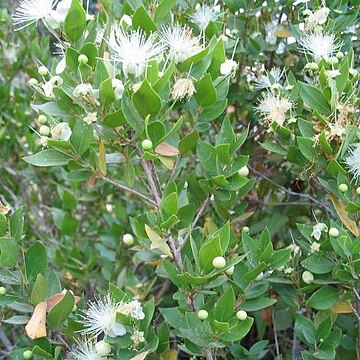Trees, shrubs or occasionally pyrophytic subshrubs with massive rootstocks; usually evergreen; pith with internal phloem. Leaves simple, predominantly opposite, often coriaceous, mostly entire, glandular-punctate; stipules absent or very reduced. Flowers mostly regular, hermaphrodite or unisexual, solitary or in simple to complex inflorescences; bracteoles often present. Hypanthium (“calyx-tube”) ± adnate to the ovary; lobes 3–6(–10), imbricate, valvate, splitting irregularly or forming an operculum. Petals 4–5(–6) or rarely absent, included on the margin of the disc lining the calyx-tube, imbricate or forming an operculum. Stamens numerous, rarely only 4, 5 or 10, included on the disc margin in 1 or more rows, straight, inflexed or twice folded in bud; filaments free or connate at the base into a short tube or in 4–5 bundles opposite the petals; anthers small, 2-locular, opening by slits or less often by apical pores; connective sometimes tipped by a gland. Ovary inferior or ± superior, (1–)2–5(–16)-locular with axile or rarely parietal placentation; ovules (1–)2–many, anatropous to campylotropous; style terminal (absent in one genus). Fruit a berry or capsule (less often a drupe or nut), (1–)few(–many)-seeded, indehiscent or loculicidally dehiscent. Seeds without or with very little endosperm; embryo straight, incurved, circular or spiral
Trees or shrubs with oil glands in leaves and often other parts, mostly evergreen. Leaves alternate or opposite, rarely whorled, simple, entire or sometimes ciliate or laciniate, without or rarely with stipules. Inforescence axillary or terminal, of single flowers or variously grouped, often in a compound structure (conflorescence). Flowers bisexual or unisexual, regular or sometimes zygomorphic, often with a hypanthium, often subtended by 2 bracteoles. Sepals 5, sometimes 4 or up to 10, free or fused, imbricate. Petals 5, sometimes 4, free or fused, imbricate, sometimes absent. Sepals and petals sometimes variously fused in an operculum. Stamens 5, 10 or numerous, rarely 4, often grouped in clusters or fused in bundles; anthers basifixed to versatile, opening by slits or pores; staminodes sometimes present. Ovary superior to inferior, 1–10-locular; style terminal, simple; stigma small or capitate; ovules 1–many per locule; placentation axile, rarely lateral. Fruit a capsule or indehiscent, sometimes berry-or drupe-like. Seeds with little or no endosperm.
Stamens numerous, rarely few, inserted on the margin of the disk, 1-or more-seriate, indexed in bud or twice folded or straight; filaments free or connate at the base into a short tube or in bundles opposite the petals; anthers small, 2-celled, opening lengthwise by slits or rarely by apical pores, the connective often tipped by a gland
Ovary inferior or half-inferior, with (1)2–5(10) locules; septa sometimes incomplete; placentation axile or parietal and then often with deeply intruded placentae; ovules 1 to numerous per locule or placenta; style 1, punctiform, capitate, funnel-shaped or shallowly 2–3-lobed at the apex
Stamens usually numerous, free or basally connate; filaments often coiled or folded in the bud; anthers basifixed or dorsifixed, connective sometimes with an apical gland
Leaves usually opposite or subopposite, rarely alternate, ternate, or in fours, simple, entire, often coriaceous, pellucid-punctate
Inflorescence axillary or terminal, paniculate, thyrsoid, umbellate, cymose, racemose, or flowers solitary or fasciculate
Ovary inferior, syncarpous, 1-to many-celled, with mostly axile, rarely parietal placentas; ovules rarely solitary or few
Petals (0)4–5, imbricate, free or coherent to form a calyptra or fused to form an operculum, often with punctate glands
Petals 4–5, rarely 6 or 0, inserted on the margin of the disk lining the calyx-tube, imbricate or connivent in a mass
Sepals (0)4–5, often persistent, rarely accrescent, sometimes fused to form an operculum, often with punctate glands
Leaves simple, mostly entire, opposite or rarely alternate, glandular-punctate; stipules 0 or rarely very small
Fruit a berry, drupe or loculicidal capsule which only dehisces near the apex, rarely nut-like and indehiscent
Flowers mostly bisexual, sometimes unisexual by abortion, actinomorphic, partly or completely epigynous
Calyx-tube more or less adnate to the ovary; lobes 3 or more, imbricate or valvate or irregularly split
Seeds with no (or very little) endosperm; embryo straight, incurved, circular or spiral
Seeds 1 to many per locule; endosperm absent or scanty; embryo straight or incurved
Flowers mostly actinomorphic, hermaphrodite or polygamous by abortion
Fruit inferior, loculicidally dehiscent or indehiscent
Trees, shrubs or rhizomatous, geoxylic suffrutices
Trees or shrubs
Stipules absent

